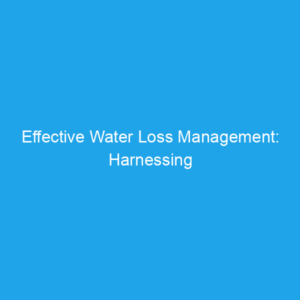THE TEXAS HIDDEN WATER CRISIS
By Sam Godfrey
In case you needed it official: The Texas Water Development Board’s Best Management Practices for Municipalities, updated last November, lays it all out.
The drought here in Texas continues, both directly and indirectly, to adversely effect a significant portion of our agricultural, commercial, and industrial enterprises as well as
many residential water users across the state.
We continue to see reminders of the Texas drought in the media and rightly so. State regulators are developing further conservation measures in an effort to ameliorate the impact of the drought on our state.
 Meanwhile, the costs of developing, processing and distributing safe, potable water to our citizens and businesses continue to rise, In this way, the value of water lost from our distribution systems increases, which significantly diminishes the financial strength of our mainly public water utility systems. But, of course, there remains ever present political and public opposition to water user rate increases.
Meanwhile, the costs of developing, processing and distributing safe, potable water to our citizens and businesses continue to rise, In this way, the value of water lost from our distribution systems increases, which significantly diminishes the financial strength of our mainly public water utility systems. But, of course, there remains ever present political and public opposition to water user rate increases.
Water industry associations, agencies and water supply entities frequently define water losses in terms of percentages. Some systems tell themselves – and the agencies to which they report – that their annual losses are
“only” 8, 10, or 15%. This means that a system producing 10 million gallons per day with a reported 10% loss would not receive revenue to cover the cost of producing an extra one million gallons per day, or approximately 365 million gallons per year, not a sum to sneeze at.
Further, these loss percentages bandied about are frequently quite optimistic, if not downright unrealistic. One statewide survey suggests a statewide urban water loss at around 15%. However, more in-depth analyses of individual systems has disclosed actual water losses in the range of 15% to 30%, with some systems reaching 40% to 50% losses and more.
Before any water utility considers any costly overhaul of its system, it should first take definitive steps to confirm its actual losses, beginning with verification of the y the measuring accuracy of its production meter(s). Without first determining with certainty how much water is produced, can it determine how much water is being lost from the system?
Then and only then, can further measures be considered. In most systems, the production meters are of a size and flow capacity that requires either Class II Turbine, Propeller, Electro-Magnetic or other types of inferential meters, all of which depend heavily on proper installation in order to deliver accurate and reliable data. So, regardless of the intrinsic accuracy that a meter may have had when leaving the factory, that performance level is attained in the field only when the specific meter is suitable for the specific application and is properly installed. Proper application and installation can be confirmed by qualified inspection and testing in place.
Why is verification of production meter installations is so important to the water system?
In an industry-heavy, municipal system on the Texas coast, an antiquated meter was being used to measure the total
intake from its raw water source into its water treatment plant. With careful and deliberate effort, this supply meter was tested and confirmed to be over-registering by 11%. As a result, the municipality had been paying 11% too much for the water they were actually receiving. By engaging a diligent and unbiased accuracy test of their source meter, this municipality was able to reduce its water purchase costs, and determine that its apparent losses from the distribution system were significantly less than previously thought.
Once a production meter is properly calibrated, some of these follow-up actions may be needed:
A. Distribution system flow measurements and analyses to evaluate the existing potential for underground leakage,
system-wide, by zone, or sector.
B. Field inspections of existing customer meter connections and interconnections, to determine condition and conformance with appropriate size, type, installation requirements, etc.
C. Evaluations of Customer Meter Reading, Billing and Data Management procedures.
D. Leak surveys to pinpoint locations where water is escaping from the distribution network (the need for which may be determined from the results of the flow measurements in A above).
Utilities must bring their hidden water crisis into the open because, unlike drought, it’s a crisis they can do something about.


 SAMCO’s Sam Godfrey will be in Dallas April 14-16 attending Texas Water 2014, the annual conference of WEAT and Texas AWWA. Stop by the SAMCO Booth #112 to learn more about how SAMCO can help you with the Hidden Crisis of Texas Water.
SAMCO’s Sam Godfrey will be in Dallas April 14-16 attending Texas Water 2014, the annual conference of WEAT and Texas AWWA. Stop by the SAMCO Booth #112 to learn more about how SAMCO can help you with the Hidden Crisis of Texas Water.








